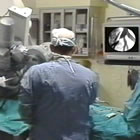|
Ad Hoc Angioplasty: A Consensus Update from SCAI
Should PCI Be Performed in the Same Session as the Diagnostic Angiogram?
|
 |
December 1, 2012 -- If a patient is getting a diagnostic angiogram, and the cardiologist sees a blockage in a coronary artery on the x-ray image, chances are that he or she will go ahead and open up that blockage on the spot. Most stent and angioplasty procedures (also known as percutaneous coronary interventions or PCIs) are performed in the same session as the diagnostic catheterization -- this is referred to as "ad hoc PCI".
Although there are a number of benefits to performing both the diagnosis and interventional therapy in the same sitting, as in the case of heart attacks, the changing landscape of coronary artery disease treatment and recent concern about the overuse of stenting has prompted SCAI, the professional organization serving the interventional cardiology community, to issue a consensus statement as a guide to when ad hoc PCI should and should not be the default treatment pathway (the statement is published online in Catheterization and Cardiovascular Interventions).
Ad Hoc PCI: The "Gold Standard" for Heart Attacks
The authors of the consensus statement clearly reaffirm that performing angioplasty immediately in the setting of acute myocardial infarction or the pre-heart attack condition of acute coronary syndrome (ACS) is the current standard of care. There should be no delay in opening up the blocked artery which is causing the heart attack, once it has been identified by the angiogram. This saves lives and limits or even eliminates damage to the heart muscle. According to the National Cardiovascular Data Registry (NCDR), over 70% of all PCIs performed in the U.S. are done as emergency procedures.
Advantages of Ad Hoc PCI
Although there is valid concern over same session diagnosis and intervention, there are many good reasons why this practice has increased significantly since the beginning days of angioplasty (for more detail on this, see our Editor's Blog, "Ad Hoc Angioplasty: The Patient Is On The Table"). The major advantages of performing ad hoc PCI are:
- Cost -- It is almost 20% less expensive to do an intervention in the same session as the catheterization because much of the work gaining access to the artery has already been done as part of the diagnostic procedure. Adding on a straight-forward stent placement may add less than 30 minutes to the total procedure. Both hospital and physician are reimbursed more if the procedure is done in two separate sessions, so the total cost is less with an ad hoc PCI;
- Less Access Site Complications -- Although the risk of hematomas, bleeding, and other access site complications, primarily seen in the femoral approach, is often quoted at 4% or less, this risk is doubled if the cardiologist has to do this twice (as in a "staged" procedure where the diagnostic angiogram and PCI are done at different times);
- Patient Preference -- The vast majority of patients would prefer to "take care of the problem" without having to return to the hospital.
Is Ad Hoc PCI Appropriate for the Stable Patient?
The controversy basically surrounds treatment of the stable patient, a situation where the patient's safety is not compromised by deferring angioplasty to a later date. And the controversy is in reaction to the results of two large clinical trials of the past five years: COURAGE and SYNTAX. As lead author Dr. James C. Blankenship, of Geisinger Medical Center, Danville, Pennsylvania, told Angioplasty.Org:

James C. Blankenship, MD
Geisinger Medical Center |
"COURAGE and SYNTAX represent two ends of the spectrum of coronary artery disease, with COURAGE representing the less severe end of the spectrum and SYNTAX representing the higher degree of complexity. So the question, when you have relatively mild disease in stable patients, is "Do you really need to do PCI at all?" And COURAGE would suggest that at least it's reasonable to try optimal medical therapy and see how people do. So at the milder end of the disease spectrum one can argue that, instead of rushing in and doing ad hoc PCI, it's reasonable instead to give a trial of medical therapy first. "At the more severe end of the spectrum you have SYNTAX suggesting that, in the most complex disease subsets, there's some advantages to surgery and in any case it's reasonable to use the "heart team approach," get a surgical consultation, and stop and think about the options of surgery vs. medical therapy. So those are the two studies that have been most controversial in terms of suggesting that instead of rushing in and doing ad hoc PCI, one should stop and think about things." |
To guide interventional cardiologists, Dr. Blankenship et al have configured a "decision flow chart for ad hoc PCI." For example, if a patient has an angiographically significant blockage, a number of conditions must be met before PCI is considered appropriate: the patient must have already tried a course of maximal medical therapy, the patient must not have a high risk anatomy or compromised kidney function (because of the additional contrast dye necessary), the patient should not be experiencing discomfort or fatigue, and so on.
Although many operators already follow such guidelines intuitively, for those who have questions, the consensus statement will provide rationale and guidance, especially when discussing treatment options with patients.
Patient Empowerment: Shared Decision-Making and Informed Consent
One of the major implications of the consensus document concerns the role the patient plays in his or her own course of treatment. One issue is the patient's desire to complete everything in a single procedure, if one or more blockages are found. Dr. Blankenship told Angioplasty.Org that "patients basically beg me to do it at the same time, and if you're putting it off, most patients are disappointed...and if you're going to send them home and tell them to come back in a week, then they're really pretty unhappy about that."
But, if a thorough discussion of the possible findings and courses of action takes place with the patient prior to the diagnostic angiogram, then the issue of ad hoc vs. delayed PCI can be clarified ahead of time. In fact the consensus document specifically states that informed consent cannot be given after the patient is sedated and on the cath lab table.
What the paper does say about the patient's wishes is that informed consent should:
- Precede the procedure by enough time for the patient to ask questions and consult with family and caregivers and should be confirmed immediately before the procedure;
- Be patient centered, using a shared decision-making model involving a two-way exchange of all relevant medical and personal information between the physician and patient (and potentially others) in a collaborative approach;
- Be patient specific, with estimates of risk and benefit based on the patient's unique characteristics.
Is Patient Involvement a New Paradigm?

Robert Harrington, MD
Stanford University School of Medicine |
The increased focus on discussion with the patient before the diagnostic angiogram brings up several issues that will need to be dealt with by the interventional community. Dr. Robert Harrington, Chair of the Department of Medicine at Stanford University and an interventional cardiologist, told Angioplasty.Org that he sees this as an "evolution" and he delineated three areas where change needs to occur:
- Reimbursement -- "We're going to have to see evolve how we as practitioners are reimbursed for the care of patients with coronary disease. Because, if part of the exercise is to engage that patient in rather detailed decision-making, how that is accounted for in a reimbursement system will be important;"
- Professional Education -- "We need to educate ourselves as a community about how to have these conversations, how to talk about things like probability and risk with our patients, how to have a conversation where one is sensitive to patients' preferences, their values, perhaps the culture in which they either reside or come from. So a lot of education needs to go on in the physician community that I believe needs to begin at the medical school level;"
- Public Education -- "We need to educate the public about how to think about topics like probability and risk and how to engage in conversations with their healthcare providers, with their healthcare team."
Dr. Harrington noted that currently he only sees one of these areas where change is beginning to occur, and that is in "teaching physicians the technique, the art, if you will, of communication."
The need for these changes to begin taking place is critical, as evidenced by the fact that the SCAI Consensus Statement is but one of several recently published documents and studies that emphasize the need for better communication with the patient, and more shared decision-making -- among them the 120-plus page "2012 Guideline for the Diagnosis and Management of Patients With Stable Ischemic Heart Disease," published on this month by seven professional societies of surgeons, cardiologists, physicians and nurses.
Reported by Burt Cohen, December 1, 2012
|



